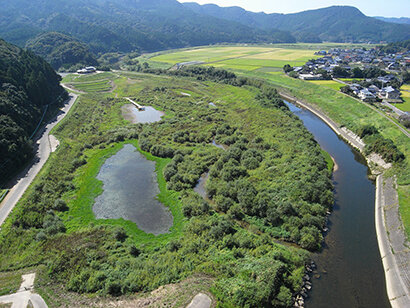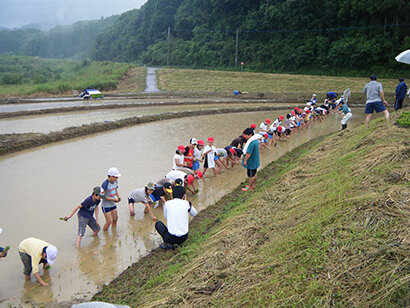- TOP
- Project Introduction
- Rich wetlands that nurture life
PROJECT INTRODUCTION
Rich wetlands that nurture life
| Location : | Middle reaches of Matsuura River (northern Saga Prefecture) |
|---|---|
| Period : | 2001 – 2010 |
| Client : | Takeo River Office, Kyushu Regional Development Bureau, Ministry of Land, Infrastructure, Transport and Tourism |
Matsuura River (Class A River) Azame-no-se Nature Restoration Project
Azame*-no-se is situated in the middle reaches of the Matsuura River, which flows through northern Saga Prefecture. It spans an area of about 6 hectares and is about 1,000 meters long and 400 meters wide. A strong levee has been built on the left bank of the river. On the other hand, there is no levee on the right bank, protecting the Azame-no-se area. This area was originally a paddy field that experienced habitual flooding every year. In 2001, the Law for the Promotion of Nature Restoration was enacted, and the River Bureau of the Ministry of Land, Infrastructure and Transport began to promote nature restoration projects. This is when the Azame-no-se Nature Restoration Project was first launched.

As mentioned above, the Azame-no-se area was unprotected by levees, so the Bureau initially considered whether to construct a levee system as a flood control measure or to acquire the land. However, it was eventually decided to acquire the land and incorporate it into the river site as a retarding basin for continued maintenance and management. Whenever the river level rises, the land becomes submerged in water. This, however, is the most distinctive feature of the area and a key element of natural regeneration.
The goals of the project were “restoration of floodplain wetlands” and “restoration of connections between people and living things.” The former, in particular, is appropriate for a nature restoration project, which “is realized based on requests from the community and upon thorough discussion, while invigorating the community.”
The floodplain ecosystem appears to be randomly shaped when viewed in aerial photos alongside geometrical channels, ponds, and terraced fields. However, it is designed in a meaningful way, including those parts of it that are underground. The ecosystem is formed by the movement and diffusion of floodwater, sediment, nutrients, organic matter, and organisms from rivers due to floods. In other words, flood frequency and disturbance are important in floodplains. When the river floods, fish escape into creeks to spawn, and their offspring return to the river as fry. We set up multiple ponds to allow different levels of access to people, including a pond with the largest variety of dragonflies in the prefecture, and aimed to restore the original satoyama environment with terraced paddies and waterways.
We incorporated the concept of adaptive development into the design process, which allowed us to make hypotheses, verify their effectiveness, and make modifications to the construction work. At first, we struggled to control the overgrowth of invasive plants. However, thanks to the maintenance and management of the area, including community volunteer activities, children’s rice planting, and natural environment surveys, the nature in the floodplain has become richer year after year.
In this project, we were mainly responsible for studying the approach for achieving the goals of the floodplain wetlands; studying and implementing the design of various areas in the floodplain, such as the terraces, reservoirs, and creeks; monitoring the environment during and after construction; and compiling the official construction records. In 2007, the project won the Civil Engineering Environment Prize sponsored by the Japan Society of Civil Engineers. In 2017, ten years after the project was completed, it won the Civil Engineering Design Prize 2017 (Grand Prize).
*Azame is a regional variation of the word azami, or thistle flower. It is said that many of them grew wild here in the past.
